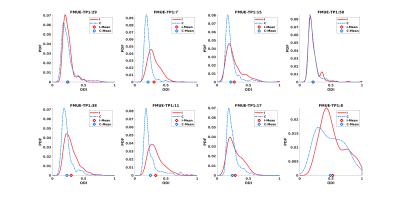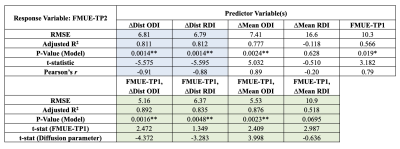Anuja Sharma1, Clint Frandsen1, Ganesh Adluru1, and Edward DiBella1
1UCAIR, Dept. of Radiology and Imaging Sciences, University of Utah, Salt Lake City, UT, United States
1UCAIR, Dept. of Radiology and Imaging Sciences, University of Utah, Salt Lake City, UT, United States
Using distribution-based measurements of diffusion microstructure improves the ability to detect subtle underlying differences. Together with baseline Fugl-Meyer scores, they significantly improve models for predicting motor outcomes in stroke patients.

Figure 1: Probability density functions (PDFs) of Orientation Dispersion Index (ODI) values from the NODDI model 6 for all stroke patients in the PLIC region of the brain. PDFs estimated for both, ipsilesional (I) and contralesional (C) sides of the brain. The corresponding mean ODI values for each PDF are also marked on the x-axis. The baseline Fugl-Meyer Upper Extremity score (FMUE-TP1) is also indicated on top of each subplot.

Table 1: Linear regression statistics for various models for PLIC region. Followup FMUE-TP2: response variable. Predictor variables are chosen from baseline as follows: A) Upper-left block (blue highlight): distribution-valued ODI and RDI observations (ΔDist). B) Upper-mid block: mean-based ODI and RDI observations (ΔMean). C) Upper-last column: Only FMUE-TP1. D) Lower block (green highlight): combination of FMUE-TP1 with either ODI or RDI diffusion parameters.
